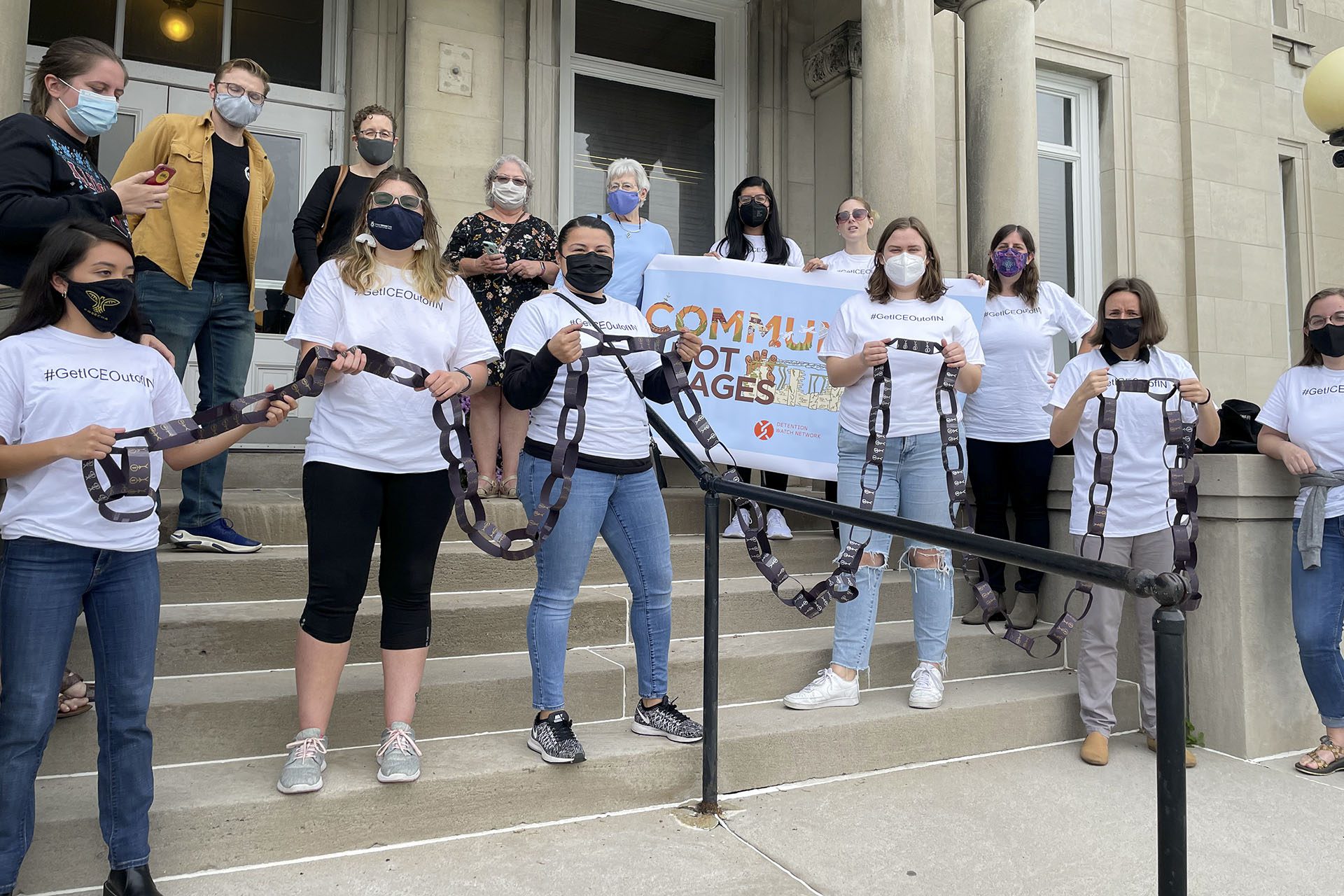 Foto cortesía de Mariposa Legal
Foto cortesía de Mariposa LegalUna demanda del Centro Nacional de Justicia para Inmigrantes alega que los inmigrantes detenidos están siendo retenidos en condiciones inhumanas, mientras que el condado de Clay hace mal uso del dinero que reciben del ICE para atender a los detenidos.
Durante los cinco meses que Javier Jaimes Jaimes estuvo retenido por el Servicio de Inmigración y Control de Aduanas en la cárcel del condado de Clay, en Brasil (Indiana), el joven de 32 años padeció ansiedad grave.
Jaimes había huido a Estados Unidos tras ser secuestrado y torturado por un cártel en México. Cuando fue detenido por el ICE, solicitó protección para permanecer en Estados Unidos, temiendo lo que le pudiera ocurrir si regresaba a México. Mientras esperaba una decisión sobre su caso, Jaimes fue detenido en el condado de Clay.
Noticias que ponen el poder en el punto de mira y a las comunidades en el centro.
Suscríbase a nuestro boletín gratuito y reciba actualizaciones dos veces por semana.
Tenía problemas para dormir por la noche en la cárcel y tomaba antidepresivos y ansiolíticos. Pero dice que después de tomar las pastillas durante un tiempo, los guardias le dieron lo que parecía la medicación equivocada dos veces.
Jaimes, que sólo habla español, no podía comunicarse con el personal, ya que no había guardias ni otro personal que hablara español con fluidez en el lugar. Y no había personal médico disponible en ese momento para decirle qué era la medicación que le dieron los guardias.
Preocupado por su seguridad, tuvo que recurrir a otros detenidos en la abarrotada cárcel para que le tradujeran.
"Las condiciones en el centro de detención del condado de Clay son muy malas", dijo Jaimes. "Las celdas están superpobladas, el agua está demasiado caliente o demasiado fría y todas las paredes están cubiertas de grafitis".

En abril, Jaimes y otros tres inmigrantes detenidos demandaron al condado de Clay y al ICE ante un tribunal federal. (para leer la demanda en español haga clic aquí) alegando que el centro no cumple las normas de detención y mantiene allí a los inmigrantes en condiciones deplorables e injustas. Junto con Jaimes, también son demandantes Cristhian Herrera Cárdenas, Baijebo Toe y Maribel Xirum.
La demanda también acusaba al condado de hacer un uso indebido de los ingresos procedentes de los contratos con el ICE, que se destinan al cuidado de las personas detenidas. En lugar de destinarse a provisiones como ropa, comida y alojamiento higiénico, la demanda decía que "el condado ha tratado el acuerdo como una gallina de los huevos de oro". Los fondos se han utilizado para aumentar los salarios del personal de la cárcel, instalar una unidad de aire acondicionado de $83.000 en el juzgado del condado y evitar subidas de impuestos en todo el condado, según los comisionados del condado.
En 2020, el condado recibió $1,4 millones por detener a inmigrantes en su cárcel. Esto supone más de 70% del presupuesto anual de $1,9 millones de la cárcel.a pesar de que los inmigrantes detenidos constituyen sólo 34% o menos de la población carcelaria total.
Cuando se le preguntó acerca de las acusaciones, un representante del ICE dijo a Borderless que la agencia no hace comentarios sobre litigios pendientes. El Departamento del Sheriff del Condado de Clay no respondió a las repetidas solicitudes de entrevista.
La demanda es la última de una serie de quejas contra la cárcel del condado de Clay, situado en la zona rural del centro de Indiana, a unos 100 km al oeste de Indianápolis. El condado tiene un acuerdo con el ICE y el Servicio de Alguaciles de EE.UU. para retener a los inmigrantes en espera de una decisión sobre su caso de asilo o inmigración. La cárcel es el único centro de detención de inmigrantes que queda entre Kentucky y Wisconsin, tras la decisión adoptada el pasado mes de febrero por Illinois de prohibir a partir de este año la detención de inmigrantes en todo el estado, tanto privada como gestionada por los condados.
Durante el apogeo de la pandemia, en mayo del año pasado, inmigrantes detenidos en la cárcel presentaron una denuncia de derechos civiles contra el condado de Clay, diciendo que estaban siendo mantenidos en "condiciones que amenazan la vida." Una mujer de 28 años dijo que en la cárcel no le dijeron que tenía COVID y que su abogado tuvo que solicitar su historial médico para que se enterara. Los detenidos dijeron que no pudieron practicar el distanciamiento social y que les ocultaron información sobre cómo hacerse las pruebas de COVID.
El mismo mes, La cárcel del condado de Clay no pasó una inspección realizadas por el Grupo Nakamoto, un contratista privado que ha llevado a cabo la mayoría de las inspecciones del ICE desde 2007. Las inspecciones tienen por objeto determinar si las cárceles "seguridad, protección y condiciones". según el ICE. Sin embargo, las evaluaciones del grupo de cumplimiento son notoriamente laxas, con ICE empleados calificando sus inspecciones de "inútiles" y "muy, muy, muy difíciles de suspender". Los inspectores avisan a los centros con hasta 30 días de antelación, lo que les permite modificar temporalmente las prácticas para aprobar, y algunos optan por las inspecciones virtuales, que consisten en confiar en declaraciones no corroboradas del personal de la cárcel de que el centro cumple las normas.
El Grupo Nakamoto juzga los centros en función de las normas federales de atención conocidas como Normas Nacionales de Detención Basadas en el Rendimiento. Si un centro suspende dos evaluaciones consecutivas, el ICE debe poner fin a su uso y financiación.
En la cárcel del condado de Clay, en mayo de 2021, Nakamoto detectó 71 deficiencias en 18 normas, incluidas varias deficiencias repetidas de inspecciones anteriores.
La cárcel estuvo a punto de suspender una segunda inspección consecutiva siete meses después, lo que les habría hecho perder su contrato con el ICE. Pero a pesar de que el informe de Nakamoto indicaba que los niveles de saneamiento y las condiciones de reclusión eran "inaceptables", el centro pasó la inspección de diciembre de 2021. La demanda del NIJC alega que esto refleja que "el ICE y el condado trabajaron juntos para evitar la documentación de una segunda evaluación de desempeño general fallida."
"El ICE está mirando hacia otro lado", dijo Mark Feldman, abogado principal del Centro Nacional de Justicia para Inmigrantes, que está proporcionando asesoramiento pro bono en el caso junto con Sidley Austin LLP. "Pero el Congreso ha dejado claro que el ICE no puede simplemente lavarse las manos de cualquier responsabilidad cuando externaliza su detención a una cárcel del condado".

Jaimes estuvo recluido en el Centro de Detención del Condado de Clay de enero a mayo de 2022. Desde entonces ha sido trasladado al centro de detención del condado de Kay, en Oklahoma, que, según él, ha mejorado mucho con respecto al centro de Indiana.
"Las condiciones en el condado de Kay son mucho mejores. Si pudiera dar una puntuación del uno al cien, el condado de Kay sería un cien y el de Clay un treinta".
Los otros demandantes en la demanda describieron condiciones similares, como tener que limpiar sus propias celdas con suministros improvisados como champú y papel higiénico, acceso inadecuado a alimentos nutritivos, temperaturas extremadamente frías sin acceso a ropa de abrigo, moho en las paredes y mesas, atención médica inadecuada y trato despectivo a las mujeres detenidas. Xirum dijo que ha oído a guardias hacer comentarios groseros y sugerentes a las mujeres, como que son "buenas para la cama". También señaló que las mujeres se sienten obligadas a coquetear con los guardias varones para tener acceso a productos de higiene personal y otros artículos de primera necesidad.
A pesar de estas atroces condiciones, El condado de Clay planea ampliar la cárcel, una medida que costaría más de $20 millones. La ampliación propuesta duplicaría con creces el número de camas, de 176 a 441. Los comisionados del condado de Clay dicen que si la expansión sigue adelante, pedirían que el ICE aumente la cantidad que pagan al condado por persona detenida. El condado recibe actualmente $55 al día por cada inmigrante detenido en la cárcel.
Según Feldman, la propuesta señala una duplicación por parte del condado en las prácticas ilegales y el abuso continuo de los fondos de ICE. Le gustaría ver un fin permanente a la vivienda del Condado de Clay personas bajo custodia de ICE.
"El condado de Clay depende claramente de los beneficios del ICE y han estado alardeando de ello muy abiertamente en todas sus reuniones relacionadas con la ampliación", dijo. "Están actuando como si desviar los fondos fuera algo normal y la razón por la que actúan así es porque este es negocio como de costumbre para el ICE y las cárceles del condado".
Mientras el NIJC y los demandantes esperan la respuesta del gobierno y del condado, confían en que esta demanda exija responsabilidades al sistema de inmigración en su conjunto. Feldman señaló que los aspectos de esta demanda no son necesariamente exclusivos del condado de Clay.
"No es raro que un condado saque provecho de la detención de inmigrantes mientras la gente está detenida en condiciones deplorables", dijo. "Y ciertamente no es raro que el ICE mire hacia otro lado: así es esencialmente como funciona el sistema de detención del ICE".
Claudia Hernández colaboró en la elaboración de este artículo.

